The Lexington Limestone
by Rick Schrantz
The Lexington Limestone is the major rock unit exposed in the Inner Bluegrass
region of east-central Kentucky surrounding Lexington. It is mainly Middle
Ordovician in age, but locally the uppermost beds are considered Upper Ordovician
in age. It is underlain by the Tyrone Limestone (Middle Ordovician
)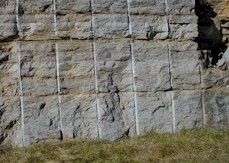 and overlain by the Clays Ferry Formation (mainly Upper Ordovician). A
bentonite layer in the upper Tyrone
is dated at 454 million years old. The Lexington's lower contact with the
Tyrone Limestone is fairly sharp, as the Tyrone
and overlain by the Clays Ferry Formation (mainly Upper Ordovician). A
bentonite layer in the upper Tyrone
is dated at 454 million years old. The Lexington's lower contact with the
Tyrone Limestone is fairly sharp, as the Tyrone
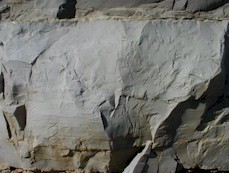 is a very pure limestone with few fossils (see figures left and right), and
is one of the premier quarry rocks in the area. The Lexington Limestone is
mostly fossiliferous limestone with minor amounts of shale. The upper contact
with the overlying Clays Ferry is fairly obvious, as the Clays Ferry has
much more shale (alternating with limestone layers) [See the figure to the
lower left. In this
image
is a very pure limestone with few fossils (see figures left and right), and
is one of the premier quarry rocks in the area. The Lexington Limestone is
mostly fossiliferous limestone with minor amounts of shale. The upper contact
with the overlying Clays Ferry is fairly obvious, as the Clays Ferry has
much more shale (alternating with limestone layers) [See the figure to the
lower left. In this
image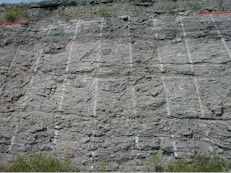 , the Clays Ferry is above the Tanglewood at the red line.
Note the contorted bedding in the lower part of the image; this is a seismite
(which results from an ancient earthquake) located north of Frankfort.]
, the Clays Ferry is above the Tanglewood at the red line.
Note the contorted bedding in the lower part of the image; this is a seismite
(which results from an ancient earthquake) located north of Frankfort.]
An excellent publication that details the Lexington Limestone and all its
members is "Lithostratigraphy and Depositional Environments of the Lexington
Limestone (Ordovician) of Central Kentucky" by Earle Cressman. It is a Geological
Survey Professional Paper (768) published in 1973.
The Lexington Limestone was named in 1898 by M. R. Campbell, and ranges from
about 200 to 320 feet thick. There are fossils to be found in it, but it
is generally not as fossiliferous as the Upper Ordovician Cincinnatian rocks
overlying it. It is important to be able to recognize certain members of
the Lexington Limestone, as that will enhance your chance of finding nice
fossils. Here is a summary of those members from the viewpoint of a fossil
collector.
-
Curdsville Member
-
This member is the basal unit of the Lexington Limestone.
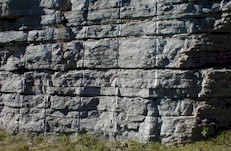 It is disconformably underlain by the Tyrone, and overlain by the Grier or
Logana members. It is about 20 - 40 feet thick, and is composed of mostly
thick layers of calcarenite limestone deposited in a shallow marine setting
above wave base. However, there are some shale partings indicative of quiet
water (perhaps in topographic low spots or protected areas), and that is
where the fossil action is! Within these shale partings, and on the limestone
surface covered by a shale parting, are excellent echinoderm fossils along
with other rare fossils. Crinoids, edrioasteroids, paracrinoids, and
Brachiospongia sponges can be found here. Collecting these fossils
is tough for several reasons: there are not many exposures of this member;
the shale partings are thin; and there is usually no talus pile of rocks
to look through at the base of a cut. In addition, although the fossils can
be spectacular, they are very sparse.
It is disconformably underlain by the Tyrone, and overlain by the Grier or
Logana members. It is about 20 - 40 feet thick, and is composed of mostly
thick layers of calcarenite limestone deposited in a shallow marine setting
above wave base. However, there are some shale partings indicative of quiet
water (perhaps in topographic low spots or protected areas), and that is
where the fossil action is! Within these shale partings, and on the limestone
surface covered by a shale parting, are excellent echinoderm fossils along
with other rare fossils. Crinoids, edrioasteroids, paracrinoids, and
Brachiospongia sponges can be found here. Collecting these fossils
is tough for several reasons: there are not many exposures of this member;
the shale partings are thin; and there is usually no talus pile of rocks
to look through at the base of a cut. In addition, although the fossils can
be spectacular, they are very sparse.
-
Logana Member
-
This member, while not always present, is
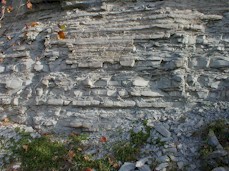 underlain by the Curdsville and overlain by the Grier. It ranges from 0 to
50 ft. thick, and exhibits repeating and fairly regular cycles of alternating
limestone and shale. The limestone and shale accumulated in deeper water
below wave base, and the grain size is finer than most of the Curdsville.
There are not many exposures of this member to be found, but there are some
around the Frankfort area. Fossils include dense brachiopod-shell horizons
(Dalmanella), and nice clam fossils. Also, a few Cryptolithus
trilobite fragments, and flattened Conularia can be
found.
underlain by the Curdsville and overlain by the Grier. It ranges from 0 to
50 ft. thick, and exhibits repeating and fairly regular cycles of alternating
limestone and shale. The limestone and shale accumulated in deeper water
below wave base, and the grain size is finer than most of the Curdsville.
There are not many exposures of this member to be found, but there are some
around the Frankfort area. Fossils include dense brachiopod-shell horizons
(Dalmanella), and nice clam fossils. Also, a few Cryptolithus
trilobite fragments, and flattened Conularia can be
found.
-
Grier Member
-
This member is the thickest member
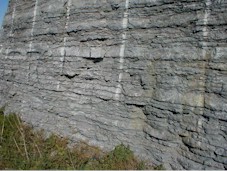 of the Lexington Limestone. It ranges from 100 to 180 feet thick, and was
deposited in shallow, moderately agitated water. It is underlain by the
Curdsville or Logana, and overlain by the Tanglewood or Brannon. It is
fossiliferous, but the fossils to be found are usually brachiopods, bryozoans,
and sometimes gastropods. It can be recognized by its thin, irregular or
nodular beds of limestone. Although it is composed largely of broken fossil
debris, fossil hunting in this member is generally unrewarding
.
of the Lexington Limestone. It ranges from 100 to 180 feet thick, and was
deposited in shallow, moderately agitated water. It is underlain by the
Curdsville or Logana, and overlain by the Tanglewood or Brannon. It is
fossiliferous, but the fossils to be found are usually brachiopods, bryozoans,
and sometimes gastropods. It can be recognized by its thin, irregular or
nodular beds of limestone. Although it is composed largely of broken fossil
debris, fossil hunting in this member is generally unrewarding
.
-
Tanglewood Member
-
This member is one of the thicker members
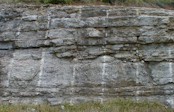 of the Lexington Limestone, ranging from 60 up to 100 ft. thick, and forms
much of the upper part of the Lexington Limestone in the Bluegrass region.
It is the surface rock in much of the Bluegrass. Its lower and upper contacts
with other members is difficult to briefly describe because of complex
intertonguing. It is generally massive looking to bedded (0.2 to 1 ft thck)
calcarenite limestone with a larger grain size than most other units of the
Lexington. The Tanglewood is cross bedded in some places. It was deposited
in a turbulent, very shallow marine enviroment. Farm ponds overlying this
member have trouble holding water. It is fossilliferous, but the fossils
are almost always broken and abraded small hash fragments. Therefore, the
fossil collecting in the Tanglewood is mostly unrewarding.
of the Lexington Limestone, ranging from 60 up to 100 ft. thick, and forms
much of the upper part of the Lexington Limestone in the Bluegrass region.
It is the surface rock in much of the Bluegrass. Its lower and upper contacts
with other members is difficult to briefly describe because of complex
intertonguing. It is generally massive looking to bedded (0.2 to 1 ft thck)
calcarenite limestone with a larger grain size than most other units of the
Lexington. The Tanglewood is cross bedded in some places. It was deposited
in a turbulent, very shallow marine enviroment. Farm ponds overlying this
member have trouble holding water. It is fossilliferous, but the fossils
are almost always broken and abraded small hash fragments. Therefore, the
fossil collecting in the Tanglewood is mostly unrewarding.
-
Perryville Member
-
This member can range from 0 to about
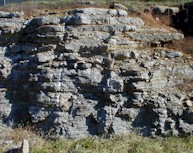 50 feet thick. It is underlain by the Tanglewood, and overlain by the Brannon
Member. There are three subdivisions of this member (Faulconer, Salvisa,
and Cornishville beds). It is exposed best in Boyle county, and the limestone
at these exposures contains silicified mollusks and brachiopods. Fossil
collecting can be good in this member. Don't forget to check the weathered
limestone surfaces for silicified fossils poking out in relief. Check the
soil above the rock cut for weathered-free silicified fossils.
50 feet thick. It is underlain by the Tanglewood, and overlain by the Brannon
Member. There are three subdivisions of this member (Faulconer, Salvisa,
and Cornishville beds). It is exposed best in Boyle county, and the limestone
at these exposures contains silicified mollusks and brachiopods. Fossil
collecting can be good in this member. Don't forget to check the weathered
limestone surfaces for silicified fossils poking out in relief. Check the
soil above the rock cut for weathered-free silicified fossils.
-
Brannon Member
-
The Brannon Member is easily recognized by its
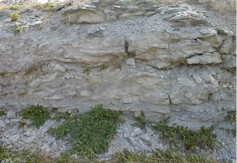 alternating layers of shale and limestone.
It ranges from 0 to 30 feet thick, and was deposited below wave base. It
is usually both underlain and overlain by the Tanglewood Member, but can
be underlain and overlain by other members. Sometimes the limestone exhibits
a ball-and-pillow structure and contorted bedding. It weathers more than
most other members of the Lexington Limestone, and is very obvious on the
high roadcut at the Kentucky River on the Bluegrass Parkway. The fossil
collecting in the Brannon is generally poor. A few brachiopods and bryozoans,
and rarely, a trilobite such as Isotelus or Proetus, can be
found in it. Many years ago, some spectacular sponges (Brachiospongia)
were found in it, but none since.
alternating layers of shale and limestone.
It ranges from 0 to 30 feet thick, and was deposited below wave base. It
is usually both underlain and overlain by the Tanglewood Member, but can
be underlain and overlain by other members. Sometimes the limestone exhibits
a ball-and-pillow structure and contorted bedding. It weathers more than
most other members of the Lexington Limestone, and is very obvious on the
high roadcut at the Kentucky River on the Bluegrass Parkway. The fossil
collecting in the Brannon is generally poor. A few brachiopods and bryozoans,
and rarely, a trilobite such as Isotelus or Proetus, can be
found in it. Many years ago, some spectacular sponges (Brachiospongia)
were found in it, but none since.
-
Millersburg Member
-
This member ranges from 0 to 90 feet thick, and
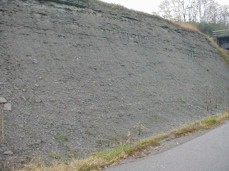 was deposited in water of moderate turbulence. It complexly intertongues
with the Tanglewood and the Clays Ferry. A Millersburg exposure is very obvious
due to its shaley, nodular appearance and rubbly weathering. A roadcut of
this layer will weather quickly. This is an excellent member for fossil hunting.
Gastropods, brachiopods, bryozoans, corals, stromatoporoids, and rare echinoderms
and trilobite pieces can be found in this member.
was deposited in water of moderate turbulence. It complexly intertongues
with the Tanglewood and the Clays Ferry. A Millersburg exposure is very obvious
due to its shaley, nodular appearance and rubbly weathering. A roadcut of
this layer will weather quickly. This is an excellent member for fossil hunting.
Gastropods, brachiopods, bryozoans, corals, stromatoporoids, and rare echinoderms
and trilobite pieces can be found in this member.
-
Strodes Creek Member
-
This member is considered a lens within the Millersburg. It is exposed in
only a few locations, generally near Winchester. It is largely limestone
and shale. Fossils found here include beautiful red algae and stromatoporoids.
-
Sulphur Well Member
-
This is locally the top member of the Lexington Limestone. It ranges from
0 to 35 feet thick, and was deposited in moderately turbulent water. It is
usually present in the southern area of the Lexington Limestone around Danville.
Fossil collecting in it can be good. A spectacular layer of edrioasteroids
has been found in Danville. Also, bored bryozoans and brachiopods can be
found in it. It is alternating layers of limestone and shale.
-
Devils Hollow Member
-
This member can range from 0 to 30 feet thick, and
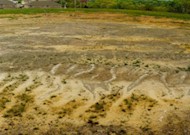 is underlain by the
Tanglewood, and overlain by the Tanglewood or Millersburg. It was deposited
in very shallow, but quiet, protected water with a higher salinity. A spectacular
series of large ripple marks (see figure to the right) was exposed in a field
where the soil was removed. Bryozoans, crinoid holdfasts, and gastropods
can be found here.
is underlain by the
Tanglewood, and overlain by the Tanglewood or Millersburg. It was deposited
in very shallow, but quiet, protected water with a higher salinity. A spectacular
series of large ripple marks (see figure to the right) was exposed in a field
where the soil was removed. Bryozoans, crinoid holdfasts, and gastropods
can be found here.
-
Stamping Ground Member
-
This member is 0 to 15 feet thick and is nodular limestone and shale. Fossils
can be found here. It is underlain and overlain by the Tanglewood.
For a more detailed geologic description of the Lexington Limestone and other
Ordovician units in Kentucky see the US Geological Survey
"Ordovician System"
[Contributions to the Geology of Kentucky], by Earle Cressman and Warren
Peterson.
 and overlain by the Clays Ferry Formation (mainly Upper Ordovician). A
bentonite layer in the upper Tyrone
is dated at 454 million years old. The Lexington's lower contact with the
Tyrone Limestone is fairly sharp, as the Tyrone
and overlain by the Clays Ferry Formation (mainly Upper Ordovician). A
bentonite layer in the upper Tyrone
is dated at 454 million years old. The Lexington's lower contact with the
Tyrone Limestone is fairly sharp, as the Tyrone
 is a very pure limestone with few fossils (see figures left and right), and
is one of the premier quarry rocks in the area. The Lexington Limestone is
mostly fossiliferous limestone with minor amounts of shale. The upper contact
with the overlying Clays Ferry is fairly obvious, as the Clays Ferry has
much more shale (alternating with limestone layers) [See the figure to the
lower left. In this
image
is a very pure limestone with few fossils (see figures left and right), and
is one of the premier quarry rocks in the area. The Lexington Limestone is
mostly fossiliferous limestone with minor amounts of shale. The upper contact
with the overlying Clays Ferry is fairly obvious, as the Clays Ferry has
much more shale (alternating with limestone layers) [See the figure to the
lower left. In this
image , the Clays Ferry is above the Tanglewood at the red line.
Note the contorted bedding in the lower part of the image; this is a seismite
(which results from an ancient earthquake) located north of Frankfort.]
, the Clays Ferry is above the Tanglewood at the red line.
Note the contorted bedding in the lower part of the image; this is a seismite
(which results from an ancient earthquake) located north of Frankfort.]
 It is disconformably underlain by the Tyrone, and overlain by the Grier or
Logana members. It is about 20 - 40 feet thick, and is composed of mostly
thick layers of calcarenite limestone deposited in a shallow marine setting
above wave base. However, there are some shale partings indicative of quiet
water (perhaps in topographic low spots or protected areas), and that is
where the fossil action is! Within these shale partings, and on the limestone
surface covered by a shale parting, are excellent echinoderm fossils along
with other rare fossils. Crinoids, edrioasteroids, paracrinoids, and
Brachiospongia sponges can be found here. Collecting these fossils
is tough for several reasons: there are not many exposures of this member;
the shale partings are thin; and there is usually no talus pile of rocks
to look through at the base of a cut. In addition, although the fossils can
be spectacular, they are very sparse.
It is disconformably underlain by the Tyrone, and overlain by the Grier or
Logana members. It is about 20 - 40 feet thick, and is composed of mostly
thick layers of calcarenite limestone deposited in a shallow marine setting
above wave base. However, there are some shale partings indicative of quiet
water (perhaps in topographic low spots or protected areas), and that is
where the fossil action is! Within these shale partings, and on the limestone
surface covered by a shale parting, are excellent echinoderm fossils along
with other rare fossils. Crinoids, edrioasteroids, paracrinoids, and
Brachiospongia sponges can be found here. Collecting these fossils
is tough for several reasons: there are not many exposures of this member;
the shale partings are thin; and there is usually no talus pile of rocks
to look through at the base of a cut. In addition, although the fossils can
be spectacular, they are very sparse.
 underlain by the Curdsville and overlain by the Grier. It ranges from 0 to
50 ft. thick, and exhibits repeating and fairly regular cycles of alternating
limestone and shale. The limestone and shale accumulated in deeper water
below wave base, and the grain size is finer than most of the Curdsville.
There are not many exposures of this member to be found, but there are some
around the Frankfort area. Fossils include dense brachiopod-shell horizons
(Dalmanella), and nice clam fossils. Also, a few Cryptolithus
trilobite fragments, and flattened Conularia can be
found.
underlain by the Curdsville and overlain by the Grier. It ranges from 0 to
50 ft. thick, and exhibits repeating and fairly regular cycles of alternating
limestone and shale. The limestone and shale accumulated in deeper water
below wave base, and the grain size is finer than most of the Curdsville.
There are not many exposures of this member to be found, but there are some
around the Frankfort area. Fossils include dense brachiopod-shell horizons
(Dalmanella), and nice clam fossils. Also, a few Cryptolithus
trilobite fragments, and flattened Conularia can be
found. of the Lexington Limestone. It ranges from 100 to 180 feet thick, and was
deposited in shallow, moderately agitated water. It is underlain by the
Curdsville or Logana, and overlain by the Tanglewood or Brannon. It is
fossiliferous, but the fossils to be found are usually brachiopods, bryozoans,
and sometimes gastropods. It can be recognized by its thin, irregular or
nodular beds of limestone. Although it is composed largely of broken fossil
debris, fossil hunting in this member is generally unrewarding
.
of the Lexington Limestone. It ranges from 100 to 180 feet thick, and was
deposited in shallow, moderately agitated water. It is underlain by the
Curdsville or Logana, and overlain by the Tanglewood or Brannon. It is
fossiliferous, but the fossils to be found are usually brachiopods, bryozoans,
and sometimes gastropods. It can be recognized by its thin, irregular or
nodular beds of limestone. Although it is composed largely of broken fossil
debris, fossil hunting in this member is generally unrewarding
. of the Lexington Limestone, ranging from 60 up to 100 ft. thick, and forms
much of the upper part of the Lexington Limestone in the Bluegrass region.
It is the surface rock in much of the Bluegrass. Its lower and upper contacts
with other members is difficult to briefly describe because of complex
intertonguing. It is generally massive looking to bedded (0.2 to 1 ft thck)
calcarenite limestone with a larger grain size than most other units of the
Lexington. The Tanglewood is cross bedded in some places. It was deposited
in a turbulent, very shallow marine enviroment. Farm ponds overlying this
member have trouble holding water. It is fossilliferous, but the fossils
are almost always broken and abraded small hash fragments. Therefore, the
fossil collecting in the Tanglewood is mostly unrewarding.
of the Lexington Limestone, ranging from 60 up to 100 ft. thick, and forms
much of the upper part of the Lexington Limestone in the Bluegrass region.
It is the surface rock in much of the Bluegrass. Its lower and upper contacts
with other members is difficult to briefly describe because of complex
intertonguing. It is generally massive looking to bedded (0.2 to 1 ft thck)
calcarenite limestone with a larger grain size than most other units of the
Lexington. The Tanglewood is cross bedded in some places. It was deposited
in a turbulent, very shallow marine enviroment. Farm ponds overlying this
member have trouble holding water. It is fossilliferous, but the fossils
are almost always broken and abraded small hash fragments. Therefore, the
fossil collecting in the Tanglewood is mostly unrewarding.
 50 feet thick. It is underlain by the Tanglewood, and overlain by the Brannon
Member. There are three subdivisions of this member (Faulconer, Salvisa,
and Cornishville beds). It is exposed best in Boyle county, and the limestone
at these exposures contains silicified mollusks and brachiopods. Fossil
collecting can be good in this member. Don't forget to check the weathered
limestone surfaces for silicified fossils poking out in relief. Check the
soil above the rock cut for weathered-free silicified fossils.
50 feet thick. It is underlain by the Tanglewood, and overlain by the Brannon
Member. There are three subdivisions of this member (Faulconer, Salvisa,
and Cornishville beds). It is exposed best in Boyle county, and the limestone
at these exposures contains silicified mollusks and brachiopods. Fossil
collecting can be good in this member. Don't forget to check the weathered
limestone surfaces for silicified fossils poking out in relief. Check the
soil above the rock cut for weathered-free silicified fossils. alternating layers of shale and limestone.
It ranges from 0 to 30 feet thick, and was deposited below wave base. It
is usually both underlain and overlain by the Tanglewood Member, but can
be underlain and overlain by other members. Sometimes the limestone exhibits
a ball-and-pillow structure and contorted bedding. It weathers more than
most other members of the Lexington Limestone, and is very obvious on the
high roadcut at the Kentucky River on the Bluegrass Parkway. The fossil
collecting in the Brannon is generally poor. A few brachiopods and bryozoans,
and rarely, a trilobite such as Isotelus or Proetus, can be
found in it. Many years ago, some spectacular sponges (Brachiospongia)
were found in it, but none since.
alternating layers of shale and limestone.
It ranges from 0 to 30 feet thick, and was deposited below wave base. It
is usually both underlain and overlain by the Tanglewood Member, but can
be underlain and overlain by other members. Sometimes the limestone exhibits
a ball-and-pillow structure and contorted bedding. It weathers more than
most other members of the Lexington Limestone, and is very obvious on the
high roadcut at the Kentucky River on the Bluegrass Parkway. The fossil
collecting in the Brannon is generally poor. A few brachiopods and bryozoans,
and rarely, a trilobite such as Isotelus or Proetus, can be
found in it. Many years ago, some spectacular sponges (Brachiospongia)
were found in it, but none since.
 was deposited in water of moderate turbulence. It complexly intertongues
with the Tanglewood and the Clays Ferry. A Millersburg exposure is very obvious
due to its shaley, nodular appearance and rubbly weathering. A roadcut of
this layer will weather quickly. This is an excellent member for fossil hunting.
Gastropods, brachiopods, bryozoans, corals, stromatoporoids, and rare echinoderms
and trilobite pieces can be found in this member.
was deposited in water of moderate turbulence. It complexly intertongues
with the Tanglewood and the Clays Ferry. A Millersburg exposure is very obvious
due to its shaley, nodular appearance and rubbly weathering. A roadcut of
this layer will weather quickly. This is an excellent member for fossil hunting.
Gastropods, brachiopods, bryozoans, corals, stromatoporoids, and rare echinoderms
and trilobite pieces can be found in this member. is underlain by the
Tanglewood, and overlain by the Tanglewood or Millersburg. It was deposited
in very shallow, but quiet, protected water with a higher salinity. A spectacular
series of large ripple marks (see figure to the right) was exposed in a field
where the soil was removed. Bryozoans, crinoid holdfasts, and gastropods
can be found here.
is underlain by the
Tanglewood, and overlain by the Tanglewood or Millersburg. It was deposited
in very shallow, but quiet, protected water with a higher salinity. A spectacular
series of large ripple marks (see figure to the right) was exposed in a field
where the soil was removed. Bryozoans, crinoid holdfasts, and gastropods
can be found here.